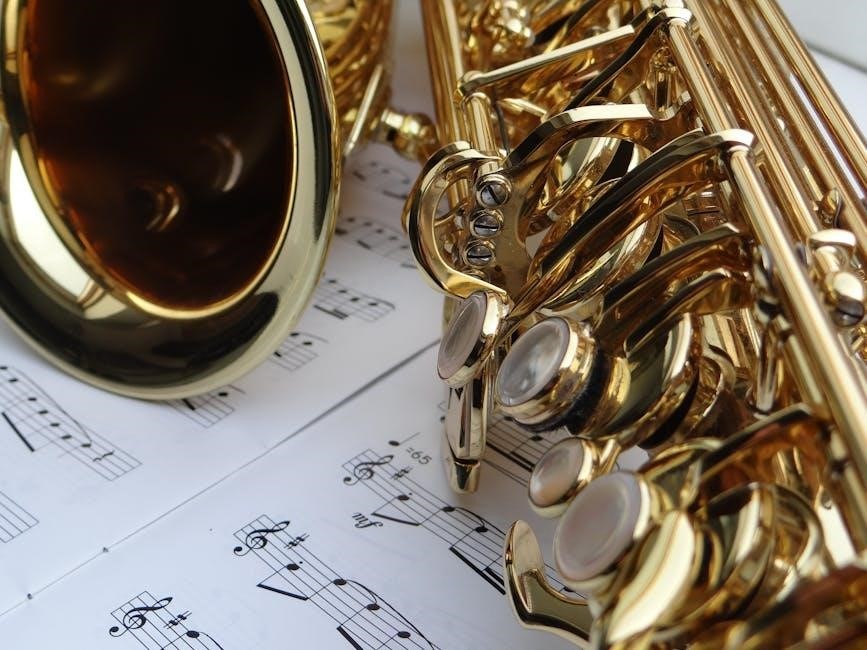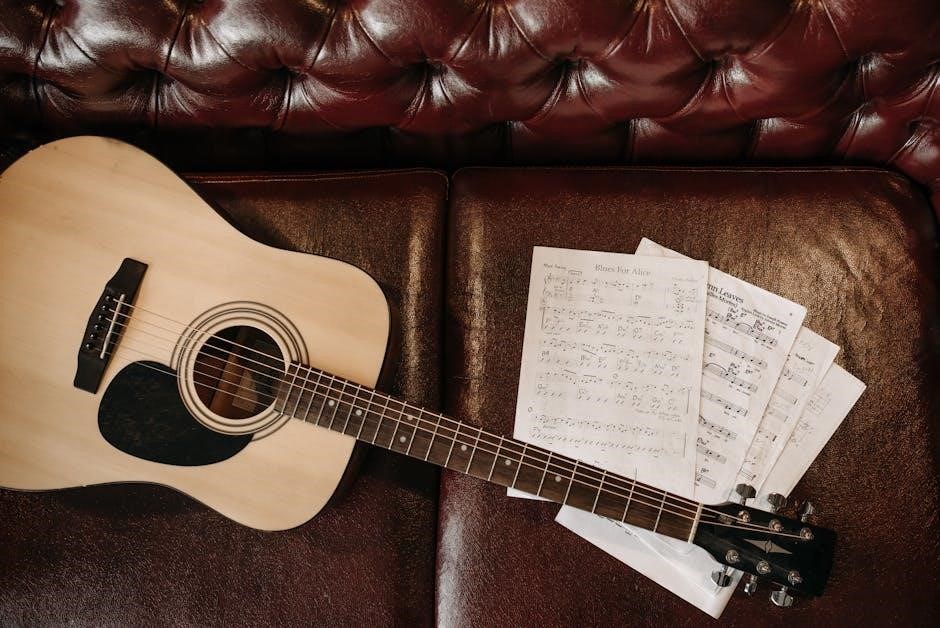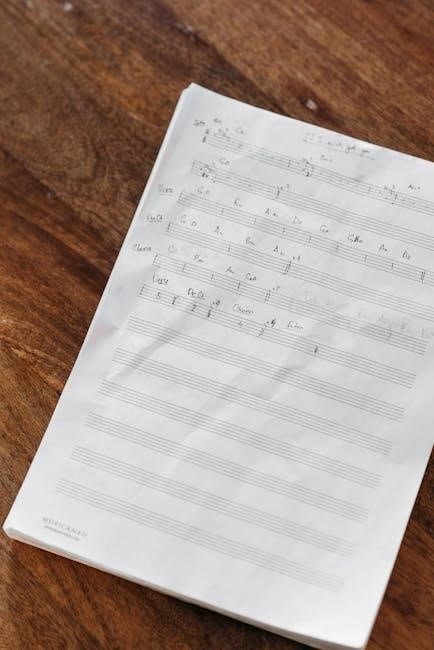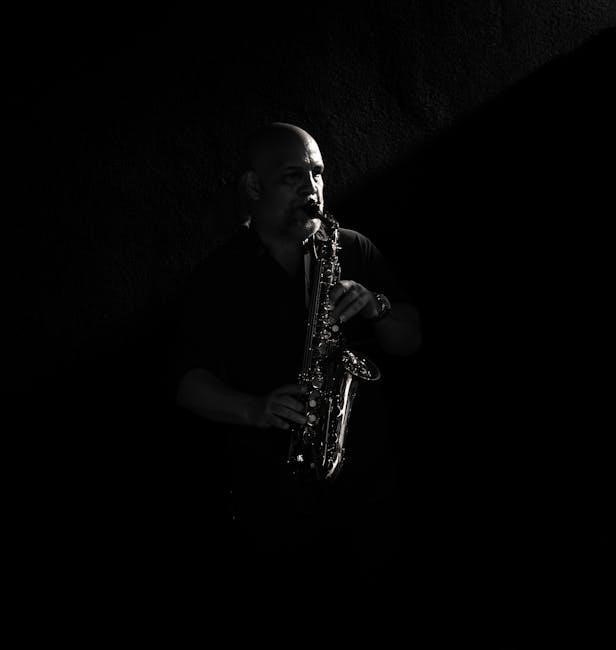“Misty” by Erroll Garner is a timeless jazz standard, now available as alto sax sheet music in PDF and MIDI formats. Perfect for saxophonists of all levels, it features the iconic melody, harmony, and chord progressions, making it a must-have for jazz enthusiasts. The sheet music is licensable, ensuring high-quality arrangements for practice and performance, catering to both beginners and advanced players.
1.1 Overview of the Song “Misty”
“Misty” is a timeless jazz ballad composed by Erroll Garner in 1954. Its dreamy, melancholic melody and lush harmonies have made it a favorite among musicians and audiences alike. The song’s haunting beauty and expressive qualities make it an ideal piece for the alto saxophone, allowing players to showcase both technical skill and emotional depth. Originally written as an instrumental, “Misty” has since been covered by countless artists, further cementing its place as a jazz standard.
1.2 Importance of Sheet Music for Saxophonists
Sheet music is essential for saxophonists, providing a clear guide to notes, rhythms, and dynamics. It ensures accuracy in playing “Misty,” helping musicians master the melody and harmony. For alto saxophonists, sheet music is a foundation for learning proper fingerings, breath control, and phrasing. It also aids in understanding chord progressions, enabling better improvisation. Accessing sheet music in PDF format allows for easy practice and performance, making it a vital tool for both beginners and advanced players aiming to refine their technique and expressiveness.
1.3 Why Choose PDF Format for Sheet Music
PDF format is ideal for sheet music due to its portability and consistency across devices. It maintains clear notation and formatting, ensuring the music appears as intended. PDFs are easily sharable and accessible on tablets, smartphones, and computers, making practice convenient. Additionally, PDFs can be annotated or transposed using software, allowing saxophonists to customize “Misty” for their needs. This versatility and reliability make PDF a preferred choice for musicians seeking high-quality, adaptable sheet music.

Background and History of “Misty”
“Misty,” composed by Erroll Garner in 1954, is a timeless jazz standard. Introduced in a live concert, it gained fame through Ella Fitzgerald’s rendition and remains a popular alto sax piece, featured in various films and media.
2.1 Composition and First Performance
Composed by Erroll Garner in 1954, “Misty” was first performed during a live concert. Garner, a renowned pianist, created the piece spontaneously, showcasing his improvisational genius. The song gained fame after Johnny Burke added lyrics in 1959. Its lush, dreamy melody and harmonic complexity made it an instant jazz standard. Over time, “Misty” has been adapted for alto saxophone, becoming a staple in jazz repertoire, celebrated for its emotional depth and timeless appeal.
2.2 Erroll Garner and His Legacy
Erroll Garner, a self-taught pianist, left an indelible mark on jazz. Known for his unique style blending melody and improvisation, he became a legend without formal training. “Misty” remains his most iconic piece, but his legacy extends to countless compositions and performances. Garner’s ability to evoke emotion through music inspired generations, solidifying his place as one of jazz history’s greatest pianists. His influence continues to resonate, making his work timeless for saxophonists and jazz enthusiasts alike.
2.3 Popular Versions and Covers
Erroll Garner’s ‘Misty’ has been covered by numerous artists, showcasing its timeless appeal. Ella Fitzgerald’s vocal rendition and Johnny Hodges’ saxophone interpretation are particularly notable. These versions highlight the song’s versatility and enduring popularity in jazz. Such covers have inspired saxophonists to explore and personalize ‘Misty,’ keeping it a beloved and enduring piece in jazz repertoire.

Structure of “Misty” Alto Sax Sheet Music
The sheet music features a rich composition with a memorable melody, harmonic depth, and a smooth arrangement tailored for alto sax, capturing the song’s soulful essence perfectly.
3.1 Melody and Harmony
The melody of “Misty” is smooth and soulful, with a flowing contour that suits the alto saxophone perfectly. The harmony is rich, featuring extended chords and modal interchange, creating a lush, jazz-inspired sound. The interplay between melody and harmony is intricate yet accessible, making it a rewarding piece for saxophonists to explore. The balance of simplicity and complexity in its structure allows for both expressive interpretation and technical precision, ensuring a captivating performance every time.
3.2 Chord Progressions and Improvisation
The chord progressions in “Misty” are iconic, featuring a timeless jazz harmonic structure. The song’s ii-V-I progression and use of extended chords create a rich foundation for improvisation. Saxophonists can explore the Dorian and major scales over these changes, adding depth to their solos. The sheet music provides a clear guide for navigating the chords, allowing players to express their creativity while staying true to the song’s essence. This makes “Misty” a standout piece for refining improvisational skills.
3.3 Arrangement for Alto Saxophone
The arrangement of “Misty” for alto saxophone is tailored to highlight the instrument’s expressive qualities. The sheet music often includes a clear melody line, phrasing markings, and dynamic suggestions to guide interpretation. Key adjustments in register ensure the music lies comfortably within the alto sax’s range. Breath marks and articulation cues further enhance playability, making the arrangement accessible while preserving the song’s lyrical beauty and emotional depth.

Key and Tempo for Alto Sax Performance
The original key of “Misty” is C Major, but it’s often transposed for alto sax; A moderate tempo of 96 BPM is typical, allowing smooth phrasing and a lush, jazzy feel.
4.1 Original Key and Transpositions
The original key of “Misty” is C Major, but for alto sax, it’s often transposed to Eb Major to suit the instrument’s range. This transposition maintains the song’s rich, soulful quality while adapting to the saxophone’s brighter timbre. Some arrangements also modulate to other keys, such as concert C or Bb, to accommodate different skill levels or performance preferences. These transpositions ensure the melody flows naturally on the alto sax, preserving Erroll Garner’s iconic composition while making it accessible for saxophonists.
4.2 Tempo and Expression Markings
The tempo for “Misty” is typically moderate, around 96 BPM, with a lush, ballad-like feel. Expression markings emphasize dynamics, such as piano and forte, to convey the song’s emotional depth. Articulation is often legato, creating a smooth, flowing melody. Phrasing instructions guide breath control and pauses, ensuring the melody’s soulful delivery. The tempo and markings evoke the dreamy, introspective mood of the song, encouraging saxophonists to interpret the music with sensitivity and nuance for a captivating performance.

Performance Tips for “Misty” on Alto Sax
Mastering “Misty” requires attention to dynamics, subtle vibrato, and expressive phrasing. Emphasize breath control, tone quality, and emotional connection. Adjust your mouthpiece for optimal resonance and pitch accuracy.
5.1 Breathing and Phrasing Techniques
Mastering “Misty” on the alto sax requires precise breathing and phrasing. Use diaphragmatic breathing to sustain long, flowing phrases smoothly. Practice the melody with a singing, legato quality, emphasizing natural pauses for breath. Focus on phrasing that mirrors the song’s lyrical intent, ensuring each note connects emotionally. Pay attention to dynamic control and subtle vibrato to enhance expression. Take deep breaths before complex passages to maintain consistent tone and pitch, especially in the higher register. Regular practice with a metronome will help refine timing and phrasing accuracy, making your performance captivating and heartfelt.
5.2 Dynamics and Articulation
Dynamics and articulation are key to delivering a compelling performance of “Misty.” Start with soft, delicate phrasing in the verses, gradually increasing volume in the chorus for emotional impact. Use subtle crescendos and decrescendos to enhance the melody’s contour. Articulate notes with a mix of legato and staccato to match the song’s expressive nature. Pay attention to accents and slurs, as they add texture and rhythm. Practice varying dynamics to create contrast and depth, ensuring each section flows naturally into the next, maintaining the piece’s signature elegance and sophistication.
5.3 Interpretation and Emotional Expression
Interpretation and emotional expression are vital for capturing the essence of “Misty.” The saxophone’s rich, velvety tone is perfect for conveying the song’s melancholic yet dreamy quality. Focus on phrasing that feels natural and heartfelt, as if telling a story. Experiment with subtle vibrato and tonal shading to add depth; Connect with the melody’s emotional core, allowing your personality to shine through. Practice interpreting dynamics and pauses to create a sense of longing and introspection, making the performance uniquely yours while staying true to the song’s timeless beauty and soul.

Versions of “Misty” Alto Sax Sheet Music
Explore various arrangements of “Misty” tailored for alto sax, including easy-level, advanced, and jazz improvisation versions. Transpose options and MIDI files are also available for practice.
6.1 Easy-Level Arrangements
Beginners and intermediate saxophonists can enjoy simplified versions of “Misty” with reduced complexity. These arrangements focus on the core melody and basic harmonies, making them accessible to younger or less experienced players. They often feature slower tempos and clearer notation, allowing musicians to build confidence and technique. Many easy-level versions are transposed to keys that are easier for alto sax, ensuring smooth playability. Additionally, some sheet music includes backing tracks or MIDI files for practice accompaniment, enhancing the learning process.
6.2 Advanced-Level Arrangements
Advanced saxophonists can explore complex arrangements of “Misty,” featuring intricate harmonies and challenging phrasing. These versions often include extended techniques, nuanced dynamics, and advanced improvisational sections. They are ideal for musicians looking to refine their skills and interpret the song with deeper expression. Many advanced arrangements incorporate virtuosic elements, such as rapid arpeggios or complex chord substitutions, while maintaining the timeless essence of the melody. These sheets are perfect for showcasing technical prowess and artistic mastery of the alto saxophone.
6.3 Jazz Improvisation Versions
Jazz improvisation versions of “Misty” offer saxophonists the freedom to explore the song’s iconic melody and chord progressions through spontaneous creativity. These arrangements often include chord charts, scales, and guidelines for crafting compelling solos. Players can experiment with phrasing, tonal colors, and rhythmic variations while staying true to the song’s emotional core. These versions are perfect for advancing improvisational skills and adding a personal touch to performances, making each rendition unique and deeply expressive.

Downloading “Misty” Alto Sax Sheet Music
Download “Misty” alto sax sheet music in PDF format from licensed platforms like Musicnotes or Scribd. Ensure quality and clarity for optimal performance preparation and practice.
7.1 Licensed PDF Downloads
For high-quality sheet music, opt for licensed PDF downloads from reputable sources like Musicnotes or Sheet Music Plus. These platforms offer accurate, professionally arranged versions of “Misty” for alto sax, ensuring clarity and proper formatting. Licensed downloads support composers and publishers, promoting fair compensation for their work. They often include additional features like transpose options, multiple arrangements, and interactive tools. Prioritize licensed downloads to access reliable, premium sheet music that enhances your practice and performance experience.
7.2 Free Sheet Music Resources
For saxophonists on a budget, free sheet music resources like MuseScore or IMSLP offer downloadable PDFs of “Misty.” These platforms provide accessible arrangements, often shared by enthusiasts. However, be cautious of legality and quality, as free versions may lack proper licensing or accuracy. While convenient, they might not include detailed dynamics or articulations. Always verify sources to ensure compliance with copyright laws and obtain reliable sheet music for your alto sax performance.
7.4 Recommended Platforms for Purchase
For high-quality “Misty” alto sax sheet music, consider purchasing from trusted platforms like Musicnotes or Sheet Music Plus. These sites offer accurate, professionally arranged PDFs, ensuring clear notation and proper formatting. They provide easy-to-download files, often with multiple versions to suit different skill levels. Additionally, platforms like JazzBooks and SaxophoneSheetMusic specialize in jazz repertoire, making them excellent choices for authentic arrangements. Purchasing from these sources supports composers and ensures you receive a reliable product.

Using Software for Practice and Performance
Software like forScore and MuseScore enhances practice with features like annotation, playback, and tempo adjustment. Tools like Transcribe! aid in learning solos and refining technique effectively.
8.1 MIDI Files for Accompaniment
MIDI files provide versatile backing tracks for practicing “Misty” on alto sax. They allow adjustable tempo and key changes, aiding in mastering the melody and improvisation. Using programs like Synthesia or GarageBand, players can isolate parts, loop sections, or add accompaniment layers. MIDI files complement PDF sheet music by enabling interactive practice, helping saxophonists refine timing and harmonic understanding. This digital tool enhances learning and performance, making it easier to perfect the iconic jazz standard with precision and expression.
8.2 Sheet Music Apps for Interactive Play
Sheet music apps like forScore and Musicnotes offer interactive features for “Misty” alto sax sheet music. These apps allow annotation, transposition, and playback, enhancing practice sessions. Saxophonists can adjust tempos, loop sections, and even use wireless pedals for hands-free page turns. Such tools provide a dynamic way to engage with the music, making learning and performance more efficient and enjoyable. They also support MIDI integration, offering a seamless experience for perfecting the piece.
8.3 Tools for Transposing and Editing
Software tools like Finale and Sibelius enable saxophonists to transpose and edit “Misty” sheet music. These programs allow users to adjust keys, modify arrangements, and customize scores to suit their performance needs. MuseScore, a free alternative, also supports transposition and editing, making it accessible for musicians. These tools are essential for tailoring the sheet music to individual preferences or ensemble requirements, ensuring a seamless and personalized performance experience.

Cultural and Historical Significance
“Misty” is a cornerstone of jazz history, composed by Erroll Garner in 1954. Its timeless melody has become a standard, symbolizing the genre’s evolution and emotional depth. The alto saxophone’s prominence in jazz is highlighted through “Misty,” showcasing its expressive capabilities. This piece bridges generations, inspiring musicians and audiences alike with its enduring charm and cultural impact.
9.1 “Misty” in Jazz History
“Misty,” composed by Erroll Garner in 1954, is a timeless jazz standard. Its lush melody and intricate chord progressions have made it a cornerstone of the genre. Originally written for piano, the piece gained fame after Johnny Burke added lyrics in 1959. Over the years, “Misty” has been covered by countless artists, solidifying its place in jazz history. Its enduring appeal lies in its ability to evoke emotion, making it a staple for improvisation and interpretation. This iconic piece continues to inspire jazz musicians and audiences alike.
9.2 The Role of Saxophone in Jazz
The saxophone is a cornerstone of jazz, offering a wide range of tonal expression. Its versatility allows for both melodic simplicity and complex improvisation, making it a favorite among jazz musicians. From bebop to smooth jazz, the saxophone’s soulful sound has shaped the genre. In pieces like “Misty,” the alto saxophone’s smooth timbre brings out the song’s emotional depth, showcasing its importance in jazz interpretation and performance. The saxophone’s role in jazz continues to evolve, maintaining its central place in the genre’s history and future.

Learning Resources and Tutorials
Explore video lessons, interactive tools, and step-by-step guides to master “Misty” on alto sax. Online platforms like YouTube and specialized websites offer tutorials tailored to all skill levels.
10.1 Online Lessons for “Misty”
Online lessons for “Misty” offer detailed guidance for alto saxophonists. Platforms like YouTube, Masterclass, and ArtistWorks provide video tutorials, while websites like TrueFire and Sax Lessons 365 specialize in jazz. Many lessons include play-along tracks, sheet music, and tips for mastering the melody and improvisation. Beginners can learn proper phrasing, while advanced players can refine their technique. These resources are ideal for practicing at home and improving performance quality, ensuring a deeper understanding of the song’s nuances.
10.2 Community Forums and Discussions
Community forums and discussions provide valuable insights for saxophonists learning “Misty.” Platforms like Reddit’s r/saxophone and specialized music forums host conversations about techniques, interpretations, and sheet music accuracy. Musicians share tips on mastering the melody, improving improvisation, and adapting the song to different styles. These spaces foster collaboration, offering feedback and encouragement. Engaging with communities helps saxophonists refine their craft and gain confidence in performing “Misty,” ensuring a polished and expressive rendition.
Mastery of “Misty” on alto sax is a rewarding journey, blending technical skill with emotional depth. The sheet music serves as an essential guide, ensuring precise execution and heartfelt interpretation, making it a timeless classic for saxophonists.
11.1 Final Thoughts on “Misty” Sheet Music
“Misty” alto sax sheet music is a timeless piece that offers a rich musical experience. Its intricate melody and harmony provide a perfect blend of technical challenge and emotional depth. Whether you’re a beginner or an advanced player, this sheet music guides you through the iconic tune’s nuances. The PDF format ensures clarity and ease of use, making it an essential resource for mastering this jazz standard. Embrace the journey of learning “Misty” and let its beauty resonate through your performance.
11.2 Encouragement for Saxophonists
Embracing “Misty” on the alto sax is a rewarding journey that enriches your musical growth. This timeless piece challenges and inspires, allowing you to express emotion deeply. Whether you’re a novice or seasoned player, its nuances will refine your skills. Stay patient, persistent, and dedicated to mastering this masterpiece. Remember, music is a journey of passion and creativity. So, take a deep breath, embrace the music, and let “Misty” flow through you.
